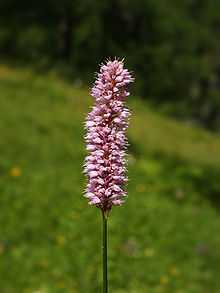Persicaria bistorta
| Persicaria bistorta | |
|---|---|
 | |
| Scientific classification | |
| Kingdom: | Plantae |
| (unranked): | Angiosperms |
| (unranked): | Eudicots |
| (unranked): | Core eudicots |
| Order: | Caryophyllales |
| Family: | Polygonaceae |
| Genus: | Persicaria |
| Species: | P. bistorta |
| Binomial name | |
| Persicaria bistorta (L.) Samp. | |
Persicaria bistorta (bistort, common bistort) is a species of flowering plant native to Europe and north and west Asia. The generic placement of this species is in flux. While treated here in Persicaria, it has also been placed in Polygonum or Bistorta.
Names
The Latin name bistorta refers to the twisted appearance of the root.
Numerous other vernacular names have been recorded for the species in historical texts, though none is used to any extent. Many of the following refer to the plant's use in making puddings:
|
|
|
Description
P. bistorta is an herbaceous perennial growing to 75 cm (30 in) tall by 90 cm (35 in) wide. The foliage is normally basal with a few smaller leaves produced near the lower end of the flowering stems. The leaves are oblong-ovate or triangular-ovate in shape and narrow at the base. The petioles are broadly winged. The plant blooms from late spring into autumn, producing tall stems ending in single terminal racemes that are club-like spikes, 5–7 cm (2–3 in) long, of rose-pink flowers.[2] The plant grows in moist soils and under dry conditions goes dormant, losing its foliage until adequate moisture exists again.
Cultivation
This species is grown as an ornamental garden plant, especially the form 'Superba' which has larger, more showy flowers, and has gained the Royal Horticultural Society's Award of Garden Merit.[3] It is suitable for use as a marginal or in bog gardens.
Other uses
In Northern England the plant was used to make a bitter pudding in Lent from a combination of the leaves, oatmeal, egg and other herbs. It is the principal ingredient of dock pudding or Easter-Ledge Pudding.[4] The root of Bistort can be used to produce an astringent that was used in medicine.
Gallery
-
Bistort or Easter Ledges in the spring in Scotland.
-

Common bistort stem.
-

The large-flowered cultivar Persicaria bistorta 'Superba' is grown as an ornamental plant.
-

In Vitosha, Bulgaria
References
- ↑ this name is also used for Rumex patientia
- ↑ RHS A-Z encyclopedia of garden plants. United Kingdom: Dorling Kindersley. 2008. p. 1136. ISBN 1405332964.
- ↑ http://apps.rhs.org.uk/plantselector/plant?plantid=3789
- ↑ Easter-Ledge or Dock Pudding - Historical Foods
| Wikimedia Commons has media related to Polygonum bistorta. |

